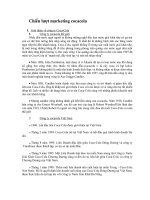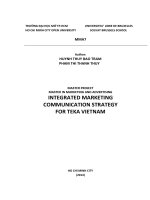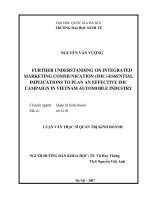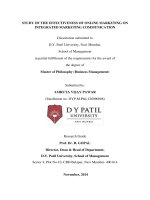integrated marketing communication coca cola 1
Bạn đang xem bản rút gọn của tài liệu. Xem và tải ngay bản đầy đủ của tài liệu tại đây (6.72 MB, 23 trang )
<span class="text_page_counter">Trang 1</span><div class="page_container" data-page="1">
<b>Integrated Marketing CommunicationCoca Cola</b>
</div><span class="text_page_counter">Trang 2</span><div class="page_container" data-page="2"><b>I express my sincere thanks to my project guide, Mr. /Dr./Ms./Mrs. </b>
<b>_______________________________________, Designation </b>
<b>_________________, Deptt______________ for guiding me right form the </b>
<b>inception till the successful completion of the project. I sincerely acknowledge </b>
<b>him/her/them for extending their valuable guidance, support for literature, critical </b>
<b>reviews of project and the report and above all the moral support he/she/they had </b>
<b>provided to me with all stages of this project. </b>
<b>I would also like to thank the supporting staff ___________________________ </b>
<b>Department, for their help and cooperation throughout our project. </b>
<b>(Signature of Student) </b>
<b>Name of the Students </b>
</div><span class="text_page_counter">Trang 3</span><div class="page_container" data-page="3"><b>Table of Content:</b>
<b>1. History </b>
<b>a. Internal Expansionb. Coke in India</b>
<b>2. Mission statement of Coca Cola Company3. Management</b>
<b>Competition-based pricingDiscount price</b>
<b>Meet-the-competition pricingPsychological pricing</b>
<b>Different Price in Different Seasons d. Promotion Strategy</b>
<b>Getting shelvesEye Catching Position Sale PromotionUTC Scheme Trade Promotione. Distribution Channels</b>
<b>Direct SellingIndirect Selling</b>
<b>7. Facilitating the Product by Infrastructure8. Advertising</b>
<b>a. Print Media b. Pos material</b>
</div><span class="text_page_counter">Trang 4</span><div class="page_container" data-page="4"><b>d. Billboards and holdingse. Internet</b>
<b>9. Expectations for the Coming Year10. How Coke Determine the Yearly Budget?</b>
<b>a. Sales volume b. Profitability c. Target volume11. Sales Promotion Activities</b>
<b>a. Coca-Cola Cricketb. Coca-Cola Concertsc. Coca-Cola Food Melad. Coca-Cola Basant Festivale. Coca-Cola GO-REDf. Coca-Cola Party in a Parkg. Coca-Cola Shopping Festivalh. Coca-Cola Pet Promotioni.Coca-Cola Ramzan Campaign</b>
<b>j.Coca-Cola Wonder of the World Promotionk. Coca-Cola & Nokia</b>
<b>l.Coca Cola TV Mazzam. Coca-Cola & Mc Donald’s12. Brand Building</b>
<b>a. Intensive brand building</b>
<b>b. Building Brand through Corporate Social Responsibilities13. Conclusion</b>
</div><span class="text_page_counter">Trang 5</span><div class="page_container" data-page="5">Coca-Cola Enterprises, established in 1986, is a young company by the standards of theCoca-Cola system. Yet each of its franchises has a strong heritage in the traditions of Coca-Cola that is the foundation for this Company. The Coca-Cola Company traces it’s beginningto 1886, when Pemberton, began to produce Coca-Cola
syrup for sale in fountain drinks. However the bottlingbusiness began in 1899 when two Chattanoogabusinessmen, Benjamin F. Thomas and Joseph B.Whitehead, secured the exclusive rights to bottle and sellCoca-Cola for most of the United States from The Coca-Cola Company. The Coca-Cola bottling system continuedto operate as independent, local businesses until theearly 1980s when bottling franchises began toconsolidate. In 1986, The Coca-Cola Company mergedsome of its company-owned operations with two large
ownership groups that were for sale, the John T. Lupton franchises and BCI HoldingCorporation's bottling holdings, to form Coca-Cola Enterprises Inc. The Company offered itsstock to the public on November 21, 1986, at a split-adjusted price of $5.50 a share. On anannual basis, total unit case sales were 880,000 in 1986.In December 1991, a mergerbetween Coca-Cola Enterprises and the Johnston Coca-Cola Bottling Group, Inc.(Johnston) created a larger, stronger Company, again helping accelerate bottlerconsolidation. As part of the merger, the senior management team of Johnston assumedresponsibility for managing the Company, and began a dramatic, successful restructuring in1992.Unit case sales had climbed to 1.4 billion, and total revenues were $5 billion.
<b>International expansion</b>
Coke’s first international bottling plants opened in 1906 in Canada, Cuba, and Panama. Bythe end of the 1920’s Coca-Cola was bottled in twenty-seven countries throughout theworld and available in fifty-one more. In spite of this reach, volume was low, qualityinconsistent, and effective advertising a challenge with language, culture, and governmentregulation all serving as barriers. Former CEO Robert Woodruff’s insistence that Coca-Colawouldn’t “suffer the stigma of being an intrusive American product,” and instead would uselocal bottles, caps, machinery, trucks, and personnel contributed to Coke’s challenges aswell with a lack of standard processes and training degrading quality.
</div><span class="text_page_counter">Trang 6</span><div class="page_container" data-page="6">Coca-Cola continued working for over 80 years on Woodruff’s goal: to make Coke availablewherever and whenever consumers wanted it, “in arm’s reach of desire.” The SecondWorld War proved to be the stimulus Coca-Cola needed to build effective capabilitiesaround the world and achieve dominant global market share. Woodruff’s patrioticcommitment “that every man in uniform gets a bottle of Coca-Cola for five cents, whereverhe is and at whatever cost to our company” was more than just great public relations. As aresult of Coke’s status as a military supplier, Coca-Cola was exempt from sugar rationingand also received government subsidies to build bottling plants around the world to serveWWII troops.
<b>Coke in India</b>
Coca-Cola was the leading soft drink brand in India until 1977 when it left rather thanreveals its formula to the government and reduces its equity stake as required under theForeign Exchange Regulation Act (FERA) which governed the operations of foreigncompanies in
India. After a 16-year absence, Coca-Cola returned to India in 1993, cementing its presencewith a deal that gave Coca-Cola ownership of the nation's top soft-drink brands and bottlingnetwork. Coke’s acquisition of local popular Indian brands including Thumbs Up (the mosttrusted brand in India), Limca, Maaza, Citra and Gold Spot provided not only physicalmanufacturing, bottling, and distribution assets but also strong consumer preference. Thiscombination of local and global brands enabled Coca-Cola to exploit the benefits of globalbranding and global trends in tastes while also tapping into traditional domestic markets.Leading Indian brands joined the Company's international family of brands, including Coca-Cola, diet Coke, Sprite and Fanta, plus the Schweppes product range. In 2000, thecompany launched the Kinley water brand and in 2001, Shock energy drink and thepowdered concentrate Sunfill hit the market.
<b>The Mission Statement of the Coca Cola Company:</b>
</div><span class="text_page_counter">Trang 7</span><div class="page_container" data-page="7">Our mission statement is to maximize shareowner value over time. In order to achieve thismission, we must create value for all the constraints we serve, including our consumers, ourcustomers, our bottlers, and our communities. The Coca Cola Company creates value byexecuting comprehensive business strategy guided by six key beliefs:
1. Consumer demand drives everything we do.
2. Brand Coca Cola is the core of our business
3. We will serve consumers a broad selection of the non alcoholic ready-to-drink beveragesthey want to drink throughout the day.
4. We will be the best marketers in the world.
5. We will think and act locally.
6. We will lead as a model corporate citizen.
The ultimate objectives of our businessstrategy are to increase volume, expand ourshare of worldwide non-alcoholic ready todrink beverages sales, maximize our long-term cash flows, and create economic valueadded by improving economic profit. TheCoca Cola system has more than 16 millioncustomers around the world that sells or
serves our products directly to consumers. We keenly focus on enhancing value for thesecustomers and helping them grow their beverage businesses. We strive to understand eachcustomer’s business and needs, whether that customer is a sophisticated retailer in adeveloped market or a kiosk owner in an emerging market. There are nearly 6 millionpeople in the world who are potential consumers of our company’s product. Ultimately, oursuccess in achieving our mission depends on our ability to satisfy more of their beverageconsumption demands and our ability to add value for customers. We achieve this when weplace the right products in the right markets at the right time.
The hierarchy of Coca Cola Company is as follows.
</div><span class="text_page_counter">Trang 8</span><div class="page_container" data-page="8"><b>Market Share:</b>
Coca-Cola is a leading player in the Indian beverage market with a 60 per cent share in thecarbonated soft drinks segment, 36 per cent share in fruit drinks segment and 33 per centshare in the packaged water segment.
<b>Coca-Cola launches integrated marketing communication campaign for 2007</b>
<b>To be seen in an all New Avatar- A No Nonsense Attendant on a Train Connecting</b>
</div><span class="text_page_counter">Trang 9</span><div class="page_container" data-page="9">Campaign designed to build the Coca-Cola brand from its refreshment platform to ahigher order of emotional benefit by establishing it as the universal choice whichbrings people together.
Strategy includes roll out of initiatives in the digital media like the internet i.e. buildingand promotion of online communities and also leveraging www.myenjoyzone.com-the interactive destination for Coca-Cola consumers.
Integrated communication plan to include mass media advertising on all leading TVchannels, complimented by a range of on the ground initiatives - road shows &contests across all key markets.
Latest advertising campaign conceptualized by acclaimed advertising guru &Bollywood lyricist Prasoon Joshi.
Ad filmed by the talented Ram Madhvani of Equinox films, music composed by Shankar Ehsaan Loy.
<b>-6 Mar 2007 , New Delhi : Coca-Cola, India’s largest beverage company continues its</b>
trend of creating the most powerful and appealing brand messaging for its consumers inthe country. Having made “Thanda” synonymous with “Coca-Cola”, the company todayannounced the launch of an intensive integrated marketing communication program forthe summer of 2007. Based on the theme “Sabka Thanda Ek”, the campaign has beendesigned to build the Coca-Cola brand from its refreshment platform to a higher order ofemotional benefit by establishing it as the universal choice which brings people together.As part of the integrated communication plan, a range of initiatives including massmedia advertising and leveraging the digital space like the internet are being rolled out.The new TV commercial to feature- who else but Aamir Khan, the Coca-Cola brandambassador in an all new avatar. In the ad, Aamir appears as a no nonsense attendanttraveling in a train, connecting consumers with Coca-Cola. The campaign has beenconceptualized by the creative genius Prasoon Joshi, Chairman & National CreativeDirector of McCann Erickson. To extend the reach and appeal of the new summercampaign, the company also plans to leverage the internet by building and promotingonline communities. The strategy includes leveraging www.myenjoyzone.com- theinteractive destination for Coca-Cola consumers. To compliment, the entire brandmessaging process, range of on the ground initiatives including road shows andcontests across all key markets are also being rolled out.
</div><span class="text_page_counter">Trang 10</span><div class="page_container" data-page="10"><b>Leveraging Online Media:</b>
The new brand campaign ‘Sabka Thanda Ek’ is all set to be launched on all leading TVchannels. Besides mass media, the Coca-Cola’s brand campaign for the summer willalso be extended to the new media platforms including www.myenjoyzone.com. It is aone stop interactive, online destination for Coca-Cola consumers in India. Theinnovative internet platform has over 4 Lac+ registered users, in the age band of 19-24yrs. The site is extremely contemporary in its appeal and supports “Multi User”capabilities to address all the key youth passions- be it music, gaming, cricket andmovies.
<b>MARKETING STRATEGY:</b>
</div><span class="text_page_counter">Trang 11</span><div class="page_container" data-page="11">Our local marketing strategy enables Coke to listen to all the voices around the worldasking for beverages that span the entire spectrum of tastes and occasions. What peoplewant in a beverage is a reflection of which they are, where they live, how they work andplay, and how they relax and recharge. Whether you're a student in the United Statesenjoying a refreshing Coca-Cola, a woman in Italy taking a tea break, a child in Peru askingfor a juice drink, or a couple in Korea buying bottled water after a run together, we're therefor you. We are determined not only to make great drinks, but also to contribute tocommunities around the world through our commitments to education, health, wellness, anddiversity. Coke strives to be a good neighbour, consistently shaping our business decisionsto improve the quality of life in the communities in which we do business. It's a special thingto have billions of friends around the world, and we never forget it.
<b>MARKET POSITIONING </b>
<b>Product Range</b>
The Coca-Cola Company's products include beverage concentrates and syrups, with themain product being finished beverages. The total range of Coca Cola Company in Indiaincludes:
CokeSpriteFantaDiet CokeMountain Due
Fruitopia 100% Fruit Juice
And company offers their products in different bottle sizes theseinclude:
SSRB (standers size returnable bottle)LRB (litter returnable bottle)
NRB (no return bottle or disposable bottle)PET 1.5 (1.5 litter plastic bottle)
CANS (in pack 330 ml)
</div><span class="text_page_counter">Trang 12</span><div class="page_container" data-page="12">Coca cola products are available in different packing
24 regular bottle shell6 bottle pack for 1.5 pets
12 bottles in a pack for disposable bottle24 cans in one pack.
Coca-Cola is the most well known trademark, recognised by 94 per cent of the world'spopulation. The business is very successful and holds a very good reputation.
The Coca-Cola Company uses marketing strategies to differentiate its product from itscompetitors to gain a competitive advantage. In 2002, the Coca-Cola Company extendedthe products of Coke and developed the new products Coke with lemon and Vanilla Coke.This extension responded to consumer demands and generated sales and profit.
Coca-Cola recently introduced its new low-carb C2 cola in the company's most aggressivemedia blitz since Diet Coke was released in the early 1980s. The cola giant supported C2'srollout with a marketing campaign that included television, radio, outdoor, cinema andInternet advertising. The campaign carried the tagline "Half the carbs Half the cals All thegreat taste."
The new Coca-Cola product arrives at a time when low-carb diet crazes are sweeping thenation and producing unlikely products in spades, from low-carb beer to low-carbdoughnuts. Executives at the company claim that C2 is a response to customers that seekchoices that fit their lifestyles. Weight-conscious consumers want to keep enjoying the colataste that Coca-Cola delivers, but with the option of a lower-carb, lower-cal soft drink. Coca-Cola C2 gives that freedom of choice.
<b>PRICE STRATEGY: </b>
Pricing Methods/Pricing strategies
</div>








